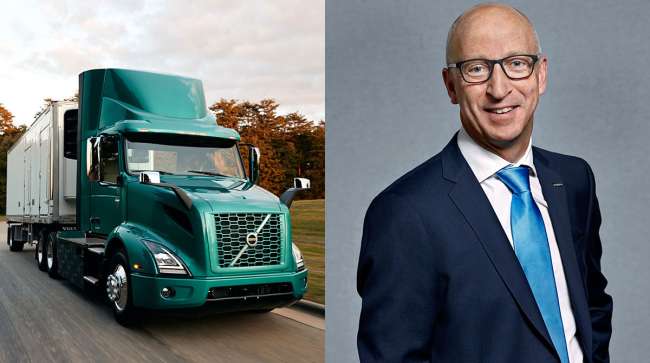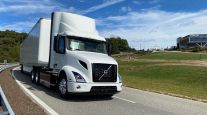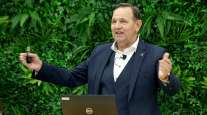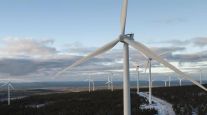Senior Reporter
Volvo Sees Three Paths to Decarbonize Trucking

[Stay on top of transportation news: Get TTNews in your inbox.]
When it comes to how best to decarbonize truck transportation, Volvo Group Chief Technology Officer Lars Stenqvist said, “Sometimes I have a feeling this debate gets too polarized.”
Volvo Group expects a near-term convergence of biofuel, battery-electric and hydrogen fuel cell electric-powered trucks as the industry, in the U.S. and in Europe, begins to adopt transformative and disruptive technologies aimed at eliminating harmful emissions and “leapfrogging” current practices.
“So no silver bullet. Three technologies in parallel. They each will have competitive advantages in different applications,” Stenqvist said in an interview May 10. “They each have to live on their own merits. I am convinced we will be helped by some kind of [added] cost on fossil-based fuels going forward, some kind of tax or some kind of penalty because that will speed up this transition.”
For certain applications and routes, fuel cell #electricvehicles will be a great option for more #sustainable #transport solutions.
Watch the replay of the digital launch of Volvo Group’s and Daimler Truck AG’s fuel cell joint venture #cellcentric at:https://t.co/AIoibFEOmQ pic.twitter.com/lJoHLnhPUY — Volvo Group (@VolvoGroup) May 10, 2021
But he forecast trucking won’t be able to get enough biofuel. There are other industries with what he called “higher needs,” so that will limit trucking’s reliance on internal combustion engines.
Biofuel as a blend is used in home and commercial heating applications and is being used in some jets.
In some areas of the globe, fossil-free fuels will happen faster than others. And eventually, electrification, coming from two angles and meeting in the middle, will “overshadow” all that, he added.
At the same time, he sees a dramatic increase in electric vehicles as prompting a huge spike in demand for electricity.
Production of electric trucks is ramping up slowly but surely in the U.S.
“We foresee, together with the research institutes we are working with, that it will be, let’s say, four to five times more electricity needed in the world,” Stenqvist said — with hundreds of thousands of trucks and millions of passenger cars “and they all need to be charged.”
Meanwhile, reliance on hydrogen fuel cells “means we don’t only build our future energy system on the electrical grid,” he said.
Stenqvist declined to lay out a timetable for Volvo bringing hydrogen fuel cells to heavy-duty trucking in North America.
He said Volvo customers should expect “something around 800 miles” between refueling with its hydrogen fuel cell trucks. Refueling time “is not exactly as quick” as diesel but much faster when it comes to charging batteries.

Next-level technologies hold the potential to enhance safety and efficiency in transportation, but it takes a lot of work behind the scenes to advance these ideas from concept to reality. We talk with Christoph Mertz of the Robotics Institute at Carnegie Mellon and Huei Peng of the University of Michigan. Hear a snippet above, and get the full program by going to RoadSigns.TTNews.com.
The hydrogen used in transportation will be a fraction of the amount used in other industries, he added, such as steel to make green steel, and the chemical industry, and the cement industry.
“But we don’t see the future production or availability of cheap green hydrogen will be a problem,” he said. “There will be a massive supply of hydrogen.”
Hydrogen can be produced from a variety of domestic resources, such as natural gas, nuclear power, biomass and renewable power like solar and wind, according to the Department of Energy. It is the most abundant element in the universe, but it rarely exists as a gas on Earth — so it must be separated from other elements.
In November, Volvo Group acquired 50% of the partnership interests in the existing Daimler Truck Fuel Cell GmbH & Co. KG for about $723 million (600 million euros). The new joint venture, Cellcentric, was announced in March with a focus on transportation and other uses for the systems.
The two truck makers are aiming at high production of fuel cells, he said. “It will be highly automated production and we have set a very, very clear cost target on where we need to be in order to be competitive compared with the other solutions.”
The model for building out the necessary hydrogen refueling infrastructure is likely to begin in earnest in Europe.
Major truck manufacturers in Europe are calling for the installation of around 300 high-performance hydrogen refueling stations suitable for heavy-duty vehicles by 2025, and for around 1,000 hydrogen refueling stations no later than 2030 in Europe.
Regulators in Europe support the infrastructure expansion, he said.
“We are really looking forward to having the same kind of conversation and discussion in North America because that will definitely be part of the plan for us in making firm introductory decisions. I see a clear shift just recently with the new administration,” and its goal of reaching net-zero emissions economywide by no later than 2050.
In the meantime, fleets facing a wave of alternative powertrains have early questions over cost, range, return on investment, maintenance in the indoor shop environment and the safety of onboard components.
Stenqvist addressed these generally saying customers should expect the same level of quality, reliability and performance as they find in the trucks they are buying today. “We can never have lower ambitions than that.”
Want more news? Listen to today's daily briefing below or go here for more info:




